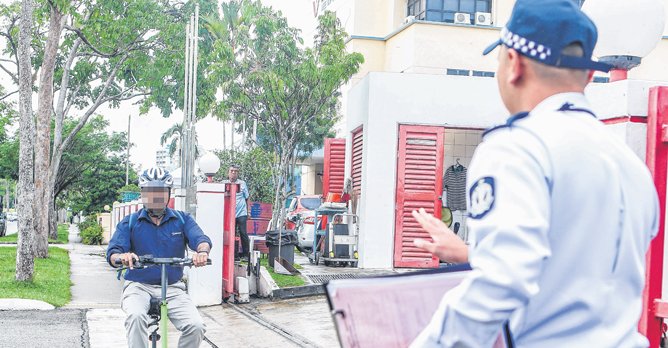More crucial to build a viable walkway network, say experts
05 Nov 2019|2,328 views
Restricting the use of electric scooters on footpaths is a step in the right direction, but building a network of pedestrian walkways is also crucial for first-and last-mile commutes, experts told The Straits Times.

The restrictions, announced on 4 November 2019 in Parliament by Senior Minister of State for Transport Lam Pin Min, mean that e-scooter riders are now allowed only on cycling paths and park connectors.
It's a "temporary setback" for last-mile commutes, said Nominated MP Walter Theseira, who added that the restrictions were a result of public education and awareness not having the "desired effect" of reducing risks. "The problem largely exists because the footpath infrastructure is not safe for PMDs and pedestrians to co-exist unless PMD users take considerable care," said Associate Professor Theseira.
As of now, the approved path network is "not close enough" to many homes and destinations, he said. But as it improves, "it will be easier for PMD users to travel while staying within the law", he said.
The Land Transport Authority (LTA) confirmed it would be widening its network of cycling paths. "We will ramp up our cycling path infrastructure as quickly as possible to enhance connectivity for PMD users. Where possible, we will try to provide cycling path connections close to residential blocks and homes," its spokesman told The Straits Times.
Associate Professor Park Byung Joon from the Singapore University of Social Sciences said things got a bit out of hand when LTA tried to solve the issue of first-and last-mile commutes.
"I think LTA was surprised how quickly PMDs became the transport of choice for some people. By the time they (LTA) introduced registration, PMDs were everywhere. So they actually had to do some kind of catch-up," he added. Motorised wheels on footpaths "should not have been allowed in the first place", Prof Park added.
However, he noted that as cycling paths are built, e-scooters would still remain as a feasible last-mile solution. For Professor Lee Der-Horng from the National University of Singapore's Department of Civil and Environmental Engineering, restricting e-scooters is a "fundamental principle" in public policy.

The footpath ban is a chance to revisit the "basics" of first-and last-mile transport, and turn Singapore into a "truly walkable" city through the possible use of extended covered walkways and walking paths enhanced with heat-absorbing material, Prof Lee noted.
Prof Theseira said, "I believe the policy intent is to continue building out the infrastructure to enable active mobility. Even public buses, although they are generally efficient compared with private car transport, tend to be inefficient for neighbourhood commuting."
Some might take to transport modes like power-assisted bicycles, and such transitions would have to be further managed, he highlighted. "Enforcement, education and awareness must always be carried out, lest we end up having to ban everything."
Restricting the use of electric scooters on footpaths is a step in the right direction, but building a network of pedestrian walkways is also crucial for first-and last-mile commutes, experts told The Straits Times.

The restrictions, announced on 4 November 2019 in Parliament by Senior Minister of State for Transport Lam Pin Min, mean that e-scooter riders are now allowed only on cycling paths and park connectors.
It's a "temporary setback" for last-mile commutes, said Nominated MP Walter Theseira, who added that the restrictions were a result of public education and awareness not having the "desired effect" of reducing risks. "The problem largely exists because the footpath infrastructure is not safe for PMDs and pedestrians to co-exist unless PMD users take considerable care," said Associate Professor Theseira.
As of now, the approved path network is "not close enough" to many homes and destinations, he said. But as it improves, "it will be easier for PMD users to travel while staying within the law", he said.
The Land Transport Authority (LTA) confirmed it would be widening its network of cycling paths. "We will ramp up our cycling path infrastructure as quickly as possible to enhance connectivity for PMD users. Where possible, we will try to provide cycling path connections close to residential blocks and homes," its spokesman told The Straits Times.
Associate Professor Park Byung Joon from the Singapore University of Social Sciences said things got a bit out of hand when LTA tried to solve the issue of first-and last-mile commutes.
"I think LTA was surprised how quickly PMDs became the transport of choice for some people. By the time they (LTA) introduced registration, PMDs were everywhere. So they actually had to do some kind of catch-up," he added. Motorised wheels on footpaths "should not have been allowed in the first place", Prof Park added.
However, he noted that as cycling paths are built, e-scooters would still remain as a feasible last-mile solution. For Professor Lee Der-Horng from the National University of Singapore's Department of Civil and Environmental Engineering, restricting e-scooters is a "fundamental principle" in public policy.

The footpath ban is a chance to revisit the "basics" of first-and last-mile transport, and turn Singapore into a "truly walkable" city through the possible use of extended covered walkways and walking paths enhanced with heat-absorbing material, Prof Lee noted.
Prof Theseira said, "I believe the policy intent is to continue building out the infrastructure to enable active mobility. Even public buses, although they are generally efficient compared with private car transport, tend to be inefficient for neighbourhood commuting."
Some might take to transport modes like power-assisted bicycles, and such transitions would have to be further managed, he highlighted. "Enforcement, education and awareness must always be carried out, lest we end up having to ban everything."
Latest COE Prices
December 2024 | 2nd BIDDING
NEXT TENDER: 08 Jan 2025
CAT A$96,000
CAT B$109,000
CAT C$69,890
CAT E$108,992
View Full Results Thank You For Your Subscription.





















